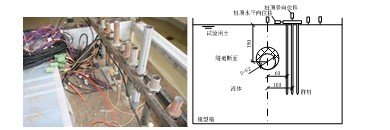Background
The underground constructions in soft soil area, such as deep excavations and shield tunnels, often encounter the problems of the soil deformation and the safety analysis due to the complexity of construction environment. Some challenges, both theoretical and practical, have emerged and many technical problems call for the innovative answers by breaking the barrier of conventional design theories. The effects from the excavation on the adjacent environment cannot be ignored, including buildings, metro tunnels and underground utilities.
Objective
The investigation of the underground constructions and deep foundations in soft soil area is based on the deformation and safety control. The limitation of conventional design has been broken through and the analysis principle for complex foundations in soft soil is obtained by taking the environmental effects and the safety control into account.
Approach
Theoretical analysis, model test, field test and engineering practice
Significant Results and Potential Impact
The three-dimensional strength theory of soft soil has been proposed by considering the rotation of principal axes of stress due to the underground excavation. The limit analysis of basal heave in the soft-clay pit excavation is raised by regarding the layered K0 consolidation. In addition, the three-dimensional analytical method of tunneling faces is presented by considering the seepage inside the tunnel; (2) Based on the back analysis, the analytical method for the deformation of the excavation is proposed by considering the small strain of soft soil. Tunneling effects on lateral behavior of pile rafts and pipelines in layered soil is investigated by the deformation-control method. The control criteria for the deformation of underground construction are summarized according to the deformation capacity of the buildings; (3) The analytical theory for the pile foundation embedded in non-homogeneous and layered soil is presented and the design philosophy of long-short composite pile foundation is proposed. Accordingly, the analysis software is developed ; (4) The centrifugal test is carried out for the piled raft foundation subject to cyclic loading and the corresponding analysis method is proposed for the settlement of piled raft foundation embedded in layered soil; (5) The centrifugal test is conducted for the bearing-capacity analysis of the uplift pile due to the deep excavation. The method for calculating the loss of bearing capacity of uplift pile under deep excavation is also presented.
Principal Investigators
Maosong Huang,Fayun Liang,Jingpei Li,Xilin Lv,Chenrong Zhang,Longlin Mu
Funding:
National Science Fund for Distinguished Young Scholars of China (Grant No. 50825803), National Basic Research Program of China (973 Program) (Grant No. 2013CB036304), National Natural Science Foundation of China (Grant Nos. 50908171, 51378392, 51008228, 51208378, 50708078), Program of Shanghai Subject Chief Scientist (Grant No. 09XD1403900)
Key Publications
(1)Linlong Mu, Maosong Huang, Kenan Lian. Analysis of pile-raft foundations under complex loads in layered soils. International Journal for Numerical and Analytical Methods in Geomechanics, 2014, 38:256–280.
(2)Maosong Huang, Chunxia Song. Upper-bound stability analysis of a plane strain heading in non-homogeneous clay. Tunnelling and Underground Space Technology, 2013, 38:213-223.
(3)Chenrong Zhang, Jian Yu, Maosong Huang. Effects of tunneling on existing pipelines in layered soils. Computers and Geotechnics, 2012, 43:12-25.
(4)Linlong Mu, Maosong Huang, Richard J Finno. Tunnelling effects on lateral behavior of pile rafts in layered soil. Tunnelling and Underground Space Technology, 2012, 28:192–201.
(5)Liang Fayun, Song Zhu. BEM analysis of interaction factor for vertically loaded dissimilar piles in saturated poroelastic soil. Computers and Geotechnics, 2014, 62: 223-231.
(6)Liang Fayun, Chen Haibing, Chen Shengli. Influences of axial load on the lateral response of single pile with integral equation method. International Journal for Numerical and Analytical Methods in Geomechanics, 2012, 36(16): 1831-1845.
Fig. 1 Influence of the principal stress axes rotation angle on the strength of soft clay

Fig. 2 Settlement control of long-short composite pile foundation on highway subgrade

Fig. 3 Loading-displacement behaviors of uplift pile

Fig. 4 Model tests for the excavation of underground construction



